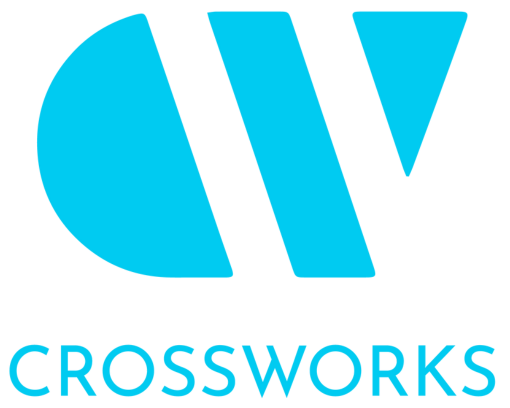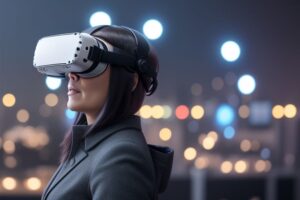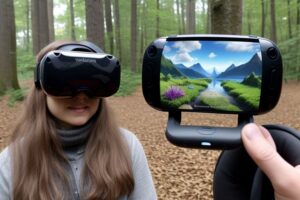In our ever-evolving technological landscape, immersive experiences have taken center stage. Two terms that are often misconstrued and used interchangeably are Mixed Reality (MR) and Virtual Reality (VR). Both offer unique experiences, and understanding the nuances between them is crucial. In this article, we’ll explore the differences between Mixed Reality and Virtual Reality, with a focus on CrossWorks, a company committed to pioneering innovation in this field.
Mixed Reality (MR) vs. Virtual Reality (VR):
Delving into the Divide
Mixed Reality and Virtual Reality may sound synonymous, but their fundamental disparities stem from how they intertwine the physical and digital realms.
Virtual Reality (VR)
Virtual Reality is an immersive technology that endeavors to construct a wholly artificial, computer-generated environment. VR is typically experienced through a specialized headset that transports users into a digital world. When you immerse yourself in VR, you are entirely disconnected from your physical surroundings, submerging you in a completely digital realm. This degree of immersion makes VR an exceptional tool for gaming, simulations, and virtual tours.
Mixed Reality (MR)
On the other hand, Mixed Reality seamlessly blends digital content with the real world. MR users can see and interact with digital objects while remaining cognizant of their physical surroundings. It’s an amalgamation of reality and digital elements. The Microsoft HoloLens, a prime example of MR, overlays holographic images onto your real-world view, creating an integrated and dynamic experience.
CrossWorks and the MR Advantage
CrossWorks is an innovative company that has been making significant strides in the realm of immersive technologies. With a primary focus on Mixed Reality, CrossWorks has harnessed MR’s distinctive attributes to enhance various industries and reimagine user experiences.
Training and Simulation
One of CrossWorks’ notable contributions lies in the field of training and simulation. Their MR solutions offer trainees the opportunity to interact with lifelike digital elements within real-world settings. This approach proves invaluable in scenarios such as training for complex industrial machinery operation or medical procedures. By integrating MR, CrossWorks ensures that learning becomes not only safer but also more engaging.
Collaboration and Communication
CrossWorks recognizes MR’s potential in transforming how teams collaborate and communicate. By creating shared MR environments, they facilitate seamless remote collaboration. Users can interact with one another and 3D digital models as if they were physically co-located. This innovation streamlines processes in product design, architecture, and engineering.
Entertainment and Gaming
CrossWorks acknowledges the entertainment value that MR offers. They’ve ventured into MR gaming, providing unique and captivating experiences that bridge the gap between the real and digital worlds. In their MR gaming solutions, players can enjoy interactive storytelling, solve puzzles, and embark on augmented reality adventures, redefining the boundaries of gaming.
The Essence of VR: A Closer Look
Virtual Reality, as its name suggests, plunges users into an entirely virtual realm. The key characteristics of VR include:
Complete Immersion: VR provides a level of immersion that is unparalleled. Users are entirely absorbed in the digital environment, with all sensory inputs originating from the virtual world. This level of immersion is highly advantageous in gaming, simulations, and training scenarios.
Isolation from the Physical World: VR headsets are designed to completely block out the physical world. While this enhances immersion, it can also lead to disorientation and potential safety concerns, as users are often unaware of their real-world surroundings.
Applications: VR is widely used in gaming, virtual tours, simulations, and medical training, where complete immersion is a central requirement.
The Distinctive Features of Mixed Reality
Mixed Reality, in contrast, integrates digital content with the physical world. Its unique characteristics encompass:
Seamless Integration: MR seamlessly merges digital objects with the real world. Users can interact with digital content while maintaining awareness of their surroundings. This feature positions MR as an ideal choice when users need to maintain situational awareness.
Physical Interaction:
MR devices frequently incorporate gestures, voice commands, and other physical interaction methods. This makes MR an excellent choice for training and collaborative applications.
Applications: Mixed Reality is finding applications across diverse fields, including industrial training, remote collaboration, architectural design, and augmented reality gaming. Its ability to enhance the real world with digital content is its defining strength.
CrossWorks’ Vision and Impact
CrossWorks stands at the forefront of this technological revolution. They understand that MR’s potential extends far beyond gaming and entertainment. Their vision is to leverage the power of MR to transform industries and enrich the lives of users in numerous ways.
Training and Simulation: CrossWorks’ MR solutions offer a safe, interactive, and engaging learning experience. Trainees can interact with virtual equipment and environments in the real world, allowing them to gain valuable skills without real-world risks.
Collaboration and Communication:
CrossWorks’ shared MR environments enable remote collaboration at an entirely new level. Teams can collaborate as if they were physically co-located, interacting with 3D models, data, and each other in an intuitive manner.
Entertainment and Gaming: CrossWorks has extended the enjoyment and excitement of MR to gaming. Their MR gaming experiences immerse players in adventures that seamlessly blend the real and virtual worlds. It’s an exciting frontier for entertainment, offering new possibilities for interactive storytelling and gameplay.
Conclusion
In the realm of immersive technology, understanding the distinctions between Mixed Reality and Virtual Reality is vital. While Virtual Reality immerses users in a completely virtual world, Mixed Reality merges digital content with the real world. CrossWorks, a visionary company, has harnessed the power of Mixed Reality to drive innovation across various industries, from training and simulation to collaboration and entertainment.
As the future unfolds, companies like CrossWorks are expected to continue pushing the boundaries of Mixed Reality, enriching our lives with immersive experiences that bridge the gap between reality and the digital realm. Whether it’s for work, play, or education, the synergy between Mixed Reality and CrossWorks promises exciting new possibilities.
Stay tuned for our next article, where we will delve even deeper into the applications and benefits of Mixed Reality in our ever-evolving world. With CrossWorks leading the way, we anticipate a future where digital and physical worlds harmoniously coexist, offering endless opportunities for innovation and exploration.




